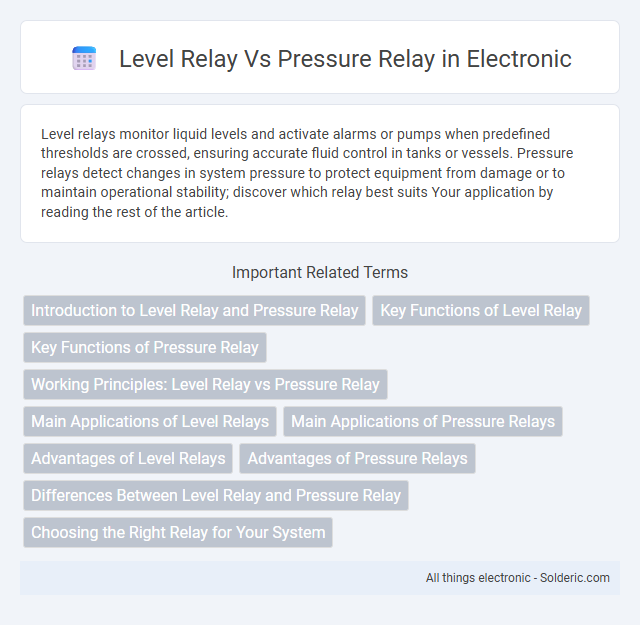Level relays monitor liquid levels and activate alarms or pumps when predefined thresholds are crossed, ensuring accurate fluid control in tanks or vessels. Pressure relays detect changes in system pressure to protect equipment from damage or to maintain operational stability; discover which relay best suits Your application by reading the rest of the article.
Comparison Table
| Feature | Level Relay | Pressure Relay |
|---|---|---|
| Function | Detects liquid level in tanks or vessels | Monitors pressure in pipes or systems |
| Application | Water level control, sump pumps, tanks | Hydraulic systems, compressors, pipelines |
| Sensing Element | Float, capacitance, ultrasonic sensor | Bourdon tube, diaphragm, strain gauge |
| Output Signal | On/off or analog level signal | On/off or analog pressure signal |
| Measurement Range | Typically 0-100% liquid level | Varies; typically 0-6000 psi or higher |
| Installation Location | Inside or on top of tank | Inline with pressure source |
| Industry Usage | Water treatment, chemical plants | Oil & gas, HVAC, manufacturing |
Introduction to Level Relay and Pressure Relay
Level relays monitor and control the liquid level in tanks by detecting the presence or absence of a fluid at a specific point, ensuring efficient process management. Pressure relays detect pressure changes within a system, triggering responses to maintain desired pressure ranges and prevent system failures. Understanding the distinct roles of level and pressure relays helps you select the right device for precise monitoring and control in fluid systems.
Key Functions of Level Relay
Level relays detect and control the presence or absence of liquid at specific points in a tank or container to prevent overflow or dry run conditions. They provide accurate monitoring by switching electrical circuits in response to changes in liquid level, ensuring system safety and operational efficiency. Your choice of level relay depends on the application's liquid type, temperature, and required sensitivity for precise level control.
Key Functions of Pressure Relay
Pressure relays monitor and control pressure levels within hydraulic and pneumatic systems by activating or deactivating electrical circuits when preset pressure thresholds are reached. They ensure safety and operational efficiency by preventing excessive pressure buildup that could damage equipment or cause system failures. Unlike level relays that detect liquid levels, pressure relays are specifically designed to respond to pressure changes, making them crucial for applications such as compressors, pumps, and pressure-sensitive control systems.
Working Principles: Level Relay vs Pressure Relay
Level relays operate by detecting the presence or absence of a liquid at a specific level using probes or float mechanisms that complete or break an electrical circuit. Pressure relays measure the pressure exerted by a fluid or gas, activating switches when preset pressure thresholds are reached through diaphragms or bourdon tubes. Understanding your application's needs will help determine whether the direct liquid level sensing of a level relay or the fluid pressure monitoring of a pressure relay is more suitable.
Main Applications of Level Relays
Level relays are primarily used in monitoring and controlling liquid levels in tanks, reservoirs, and industrial process vessels to prevent overflow or dry running of pumps. These devices are crucial in water treatment plants, chemical processing, and oil refining industries for maintaining consistent liquid levels. Unlike pressure relays that respond to pressure changes, level relays provide precise detection of surface level changes ensuring operational safety and efficiency.
Main Applications of Pressure Relays
Pressure relays are primarily used in hydraulic and pneumatic systems to monitor and control pressure levels, ensuring operational safety and efficiency. They are essential in applications such as pump control, compressor systems, and industrial automation where maintaining precise pressure thresholds is critical. Your equipment benefits from pressure relays by preventing damage caused by pressure fluctuations and enabling accurate system response.
Advantages of Level Relays
Level relays offer precise fluid level detection with minimal maintenance requirements, enhancing system reliability in industrial applications. They provide real-time monitoring and accurate control of liquid levels, reducing the risk of overflow or dry running in tanks and vessels. Their compatibility with various liquids and ability to operate under extreme conditions make level relays indispensable for efficient process automation.
Advantages of Pressure Relays
Pressure relays offer precise control and rapid response to changes in fluid or gas pressure, ensuring reliable system protection and operation. They provide durability in harsh environments, often withstanding extreme temperatures and vibrations better than level relays. Their versatility in applications such as HVAC, hydraulic systems, and industrial automation enhances overall system efficiency and safety.
Differences Between Level Relay and Pressure Relay
Level relays detect and control the presence or absence of a liquid level in tanks or vessels, using probes or floats to activate electrical contacts, while pressure relays measure and respond to pressure changes within systems, utilizing diaphragms or bourdon tubes to trigger switches. Level relays are primarily designed for liquid level automation and overflow protection, whereas pressure relays are used for monitoring system pressure to prevent overpressure or underpressure conditions. The key difference lies in their sensing parameters: level relays monitor liquid height, and pressure relays monitor fluid or gas pressure.
Choosing the Right Relay for Your System
Selecting the right relay depends on the specific control parameters: level relays are designed to monitor and control liquid levels in tanks or vessels, while pressure relays detect and regulate pressure within systems such as pipelines or compressors. Your system's requirements for accuracy and response time in detecting either liquid level or pressure changes will determine the ideal relay type. Understanding the operational environment and compatibility with sensors ensures optimal performance and system reliability.
level relay vs pressure relay Infographic

 solderic.com
solderic.com